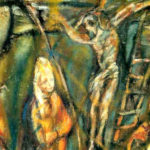We run our website the way we wished the whole internet worked: we provide high quality original content with no ads. We are funded solely by your direct support. Please consider supporting this project.
The REAL Problem with Divine Violence in the OT
As I mentioned in my previous blog, while I will continue to offer video-blogs responding to questions that come in, I’m also planning on sprinkling in reflections based on my forthcoming book, Crucifixion of the Warrior God, over the next couple months. Today, I just want to state what I consider to be the real problem that violent divine portraits pose.
Most conservative evangelical approaches to this problem attempt to demonstrate that the sometimes horrifically violent depictions of God in the OT are not as brutal and as unethical as they appear. The best recent example of this approach is Paul Copan’s Is God a Moral Monster? (Baker, 2011). This was, in fact, the challenge I originally set out to tackle five years ago. The thing that caused me to abandon this approach, and the thing that eventually opened my eyes to a radically different approach, was that I came to realize that, while there is much to learn from Copan’s book and others like it, this is not really the problem followers of Jesus face as it concerns these violent portraits. The central problem is rather that the violent depictions of God in the OT aren’t consistent with God’s own definitive revelation of himself in Jesus Christ. This sets the bar above ethics.
In fact, inasmuch as the cross is the thematic center of everything Jesus was about, as I’ve argued elsewhere, the problem is that the OT’s violent divine portraits aren’t consistent with the revelation of a God who loves enemies and would rather die as a human for enemies rather than use his power to crush them, which is precisely what is revealed on the cross. Arguing that the violent acts of Yahweh in the OT meet the standards of ethics, even if the arguments are considered plausible, doesn’t accomplish much when it comes to addressing this problem.
But even this doesn’t capture the full depth of our problem, for Jesus taught us, and the Church has always confessed, that all Scripture bears witness to Jesus (Jn 5:39, 44-47; Lk 24:25-27, 32, 44-46). In this light, it seems to me we must accept that the real problem followers of Jesus face as it concerns the violent depictions of God in the OT is that we must show how they point to the cross. That is, our task is to disclose (say) how portraits of Yahweh commanding his people to “show no mercy” as they slaughter “everything that breathes” in the land of Canaan – including women, babies and even animals (e.g. Deut.7:2; 20:16-20) — point to the non-violent, enemy-loving, self-sacrificial God revealed on the cross.
The real challenge we face, I submit, is that we must interpret violent divine portraits in such a way that we can discern the self-sacrificial God revealed on Calvary within portraits of God declaring he will use Babylon his servant to smash together parents and children (Jer. 13:14), or of God planning to trample his own “Virgin Daughter Judah” like one crushes grapes in a winepress (Lam. 1:15), or of God bringing about a judgment in which babies would be dashed to the ground and pregnant women would have their wombs ripped open (Hos. 13:16).
That is the real problem. And as it concerns this problem, arguments to the effect that God’s merciless violence against people was justified, even if successful, achieve very little. If there is any hope of resolving this problem, I submit that it lies in adopting a completely different framework. What if we, like Paul, adopted a hermeneutic that reflected Paul’s attitude toward the Corinthians when he “resolved to know nothing… except Jesus Christ crucified?”
DFID – UK Department for International Development via Compfight
Category: Essays
Tags: Bible, Crucifixion of the Warrior God, Cruciform Theology, Essay, God, Jesus, Violence
Topics: Interpreting Violent Pictures and Troubling Behaviors
Related Reading

Scientific Support for the Open View
If a position is true, every avenue of reflection ought to point in its direction. What follows are two more “pointers” to the view that the future is at least partly open (indefinite, composed of possibilities). I’ll first consider an argument from quantum physics, followed by a pragmatic argument regarding what we ordinarily assume to…

Creating God in Our Own Image
How have we created God in our own image? In this short video produced by The Work of the People, Greg reflects on various ways that humans typically think about God in terms of power, and how Jesus reframes the nature of power. The Christian revelation of God is the opposite of what we most often imagine…

Which of the Miracles of Jesus Can Humans Do? (podcast)
Greg is asked about the miracles of Jesus, specifically which miracles do we have the potential to perform. He also gives a nod to the band Theocracy. Episode 74 http://traffic.libsyn.com/askgregboyd/Episode_0074.mp3

God’s Shadow Activity [Sermon 7/15/12]
If we believe the whole Bible is inspired, how do we reconcile the Old Testament with the self-sacrificial, enemy-loving God revealed in Jesus Christ? In this past Sunday’s sermon at Woodland Hills Church, Greg succinctly summarizes his own thoughts by echoing that of the apostle Paul: the Old Testament is a shadow of the reality which is found in Christ.

Podcast: HOW Does the Death of Jesus Allow Us to Be Forgiven?
Greg discusses love bombs and explosions of light. http://traffic.libsyn.com/askgregboyd/Episode_0419.mp3

